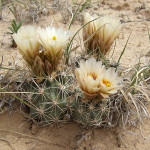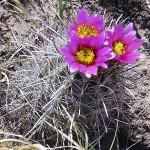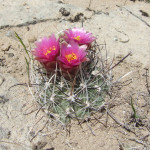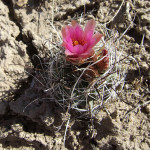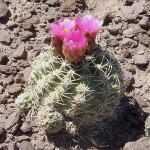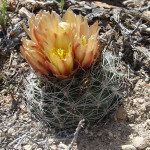(Photograph = Sclerocactus parviflorus, Dorde Woodruff)
Introduction
The genus Sclerocactus is native to the southwestern United States and northern Mexico (Cactiguide.com). The plants occur widely but sporadically often over small areas. Some species have very small home ranges and overall numbers.
The Details
Sclerocactus plants seldom branch; they form small cylinders or globes. Often the areoles produce hooked spines. Flowers and fruits arise from the apex on new growth. The fruits are dry at maturity. The flowers range from brownish-green to white or yellowish to bright magenta, often seeming large relative to plant size.
The various species find the most difficult places to grow, often growing in essentially mineral soils or on baking hot sands. Sometimes they prefer the most exposed, wind-swept locations within a particular region. Sometimes they grow on uneven soils were a few inches of water may accumulate for a few hours. They are cold hardy and grow at (4)5,000 ft and above.
There are 8-20 species. Benson reported eight species.
- S. glaucus
- S. mesae-verde
- S. wrightiae
- S. pubispinus
- S. spinosior
- S. whipplei
- S. parviflorus
- S. polyancistrus
Wikipedia reports that there are 14 species (accessed March 24, 2015).
- S. brevihamatus
- S. glaucus
- S. mesae-verdae
- S. nyensis
- S. papyracanthus
- S. parviflorus
- S. polyancistrus
- S. pubispinus
- S. scheeri
- S. sileri
- S. spinosior
- S. uncinatus
- S. whipplei
- S. wrightiae
But more species have been described, such as S. brevispinus, S. wetlandicus, and S. johnsonii. In Cacti of the Southwest, Weniger lumped Sclerocactus into Echninocactus and therefore recognized no species. The enigmatic and tiny Toumeya papyracantha is sometimes lumped into Sclerocactus.
Because of their relative rarity and cultivation problems, Sclerocactus species provide challenge and allure to hobbyists and collectors. Some species are threatened in the wild because of collectors and because there numbers were not large to begin with.
The Utah Native Plant Society (UNPS) is a non-profit organization dedicated to the appreciation, preservation, and responsible use of the native plants and plant communities found in the state of Utah and the Intermountain West. The UNPS has made tremendous contributions to the understanding of Sclerocactus.
Additional Reading: Uinta Basin Hookless Cactus Complex

